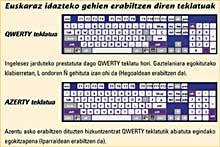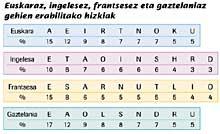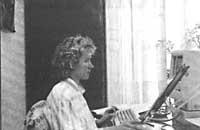Clumsy keyboards
2005/01/01 Araolaza, Oier - Elhuyar Zientziaren Komunikazioa Iturria: Elhuyar aldizkaria

According to the mechanical criteria, with the smallest finger, which has no force, we press the edge A key. We got used to the end, but after a long time of clumsiness.
Of course, in old typewriters, the keys had to be pressed hard. Eleven would eat by pressing A or Q with the smallest finger on the left hand.
Vowels are more used than consonants and, as we have seen, A is separated at the left end and, in addition, are located at the top line of the keyboard E, U, I and O. Instead of placing them nearby, therefore, they are far away, and also you have to press O with the fourth finger, the lazy.
In the current keyboard layout, letters are not located to meet the needs of use. When this design was made, the writing facility was not a priority. Consequently, the computer will have all the megaherres you want and performs its operations at full speed, but with your fingers we will keep typing on a clumsy keyboard. We get to fix enough about the practice of activity, and there are those who take the size, but until the position of each letter is inserted well into the memory we have enough work.
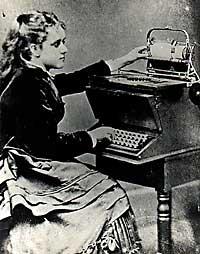
If we start thinking about how to organize the letters in the key, we will analyze the frequency of use of each key and put them accordingly. The most used in the second row, in the line in which we place the fingers when starting, and to the center, as close as possible to the index. Those we use least, on the edge, in the territory of the small and useless finger.
And what are the most commonly used letters? Although they vary from language to language, there are some similarities.
In Basque, English, French and Spanish A and E are widely used, but on keyboards they have marginal space. To write in Basque we mainly use two types of keyboards. The one used in English and Spanish, on the one hand, known as QWERTY, since they are the first six letters of the upper line. On the other hand, an adaptation is used from this QWERTY in the claviers under French influence. This variant is called AZERTY and is adapted to languages that use lots of accents.
Therefore, what criterion has been followed to organize the letters on the keyboard? Even if it seems a lie, the frequency with which each letter is used was taken into account, but not to facilitate writing, but to remove the keys from the letters. This happened at the time of typewriters and their consequences have reached the keyboards of computers.
Evolution and keyboards
Scientist and disseminator Stephen Jay Gould also dedicated a space in his writings to the peculiar organization of machine and computer keyboards. He compared the evolution of the keyboard with the curiosities that occur in biological evolution. According to Gould, the complex and curious paths of history make the design of most organisms and ecosystems not the best possible. Moreover, these design errors are, in his opinion, the clearest symptom that evolution has occurred, since if it starts to produce from zero, designs without errors would occur.
In 1714 the British engineer Henry Mill made the patent of the first typewriter. But it is not clear if he came to build the same machine. The Italian Pellegrino Turri did build a typewriter in 1808. Then several inventors made their prototype, but the success was the one created by the American Christopher Sholes.
The machine created by Sholes in the 1860s hit the paper below. The keys were sorted alphabetically and in a single long line. When trying to write fast, the letters stuck together. When the first letter was on paper and returned to its place, the second letter hit and again the first letter was on paper. Therefore, the SUN would like to write in haste and the EVE could be the result.

To solve the problem, Sholes arranged the letters in three rows, alphabetically ordered, but the letters worked the same way. So the inventor took two measures. First, he decided that letters should hit the paper from the front, so he quickly saw the mistakes. Later, to avoid jams, he decided to change the organization of the letters.
Sholes analyzed the most commonly used letters in English and, according to him, began to move away. It was about jamming the keys as little as possible, so a tool was prepared that was going to write more slowly, since speeding caused congestion. Sholes spent six years testing, changing and upgrading his machine to its final result.
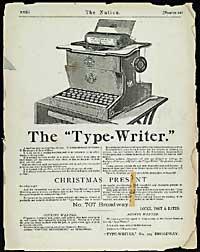
Despite changes made to the alphabetically ordered keyboard at the starting point, it is still possible to detect this origin, for example in the second line: DFGHJKL. Among the modifications carried out are one of them commercial. The reason for putting the letter R on the top line had little to do with alphabetical order, frequency of use or risk of choking. The sellers, in order to demonstrate the operation of the typewriter, used to write TYPE WRITER, and all the necessary letters were in the upper line, except R, so, in support of this task, they decided to upload the letter R to the upper line. Thus, sellers wrote the example quickly and easily to the buyer.
Sholes' machine had great competition in the 20th century. In the first decades of the 20th century. Several types of machines were launched, but Sholes' one was quite well prepared for the competition: it offered paper on cylinders, ink-impregnated tapes and, which was very important, in the typing schools they began to teach on the QWERTY keyboards.
Dvorak, best loser
In 1932, August Dvora, professor of Pedagogy, edited a keyboard that would solve the errors of QWERTY. He researched typing, hand physiology, frequency of use of letters, their location, and taking into account all this, he designed the organization of letters to write in English for the keyboard of his typewriter. The DSK keyboard (Dvorak Simplified Keyboard) was excellent, was studied immediately and allowed its use at high speed. Since then all mechanical speed records have been made with Dvorak keyboards.
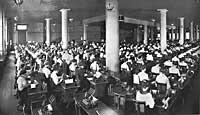
Some experts say that learning to use the Dvorak keyboard for someone starting from scratch is 20 times easier and that QWERTY keyboards make twice as many mistakes. But by the time Dvorak appeared in the market in which QWERTY was a leader, in the companies QWERTY was used, in the typing schools QWERTY was taught, and rival companies also supported the QWERTY organization of the keyboard to sell typewriters. In addition, it was a time of crisis in the U.S., and I was unable to pull old typewriters and start buying new ones.
During World War II, the military saw that Dvorak was a better system and carried out a campaign in their favor, but QWERTY had already made way, had already become a standard and Dvorak was back in the shadows. In the 70's interest in Dvorak's keyboard revived. Several magazines published articles showing the advantages of this system against QWERTY, and the writer company Smith-Corona offered in its catalog the machines of the Dvorak system. But the defeat was total and they barely sold copies. August Dvorak died in 1975, completely tormented and unable to understand the failure of his brilliant system.
Computer option

When in 1980 IBM launched the Personal Computer (PC), the keyboard was prepared with the QWERTY system. The Apple IIe computer was prepared with the possibility that Dvorak would use the system, but Apple did not tell anyone how to do it. On the arrival of Apple IIc, users could opt for the two keyboard systems, being able to use QWERTY, but also Dvorak. But few buyers knew the Dvorak system and most of them went unnoticed. Microsoft Dvorak began offering the ability to use the keyboard on pre-Windows systems. Currently all Windows system computers have this option.
If we want to use the Windows Dvorak keyboard, we must do the following. Click on the following sections: Settings Control Panel Keyboard Languages Properties. There, you will select the so-called US-DVORAK and the keyboard will work on this system. To avoid confusion, it is advisable to put on the keyboard a new position of letters with stickers.
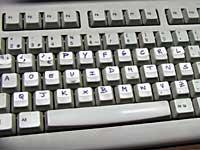
The Dvorak keyboard configuration can also be set on the Linux system. Because today we can configure the keys as we want and give each key the function we want. In the graphical environment the configuration of the keyboard is changed by the order Xmodmap and in the consola with the order Loadkeys.
Thanks to these options, in recent years Dvorak is choosing the keyboard for several users, but the superiority of the clumsy keyboard, the qwerty, is total and for the time being almost impossible to escape.

Gai honi buruzko eduki gehiago
Elhuyarrek garatutako teknologia



